Commercial flush valves are a type of plumbing used in commercial and industrial settings, such as hotels and restaurants. They can also be found in schools, hospitals, offices, and even homes with large families. These valves are different from residential ones because they must work harder to handle the increased volume of water usage. Commercial flush valves require more maintenance than residential ones but provide many benefits for those who use them.
These valves usually feature metal or plastic casing with one or more handles. The handle may look like the handle on a faucet, but it does not turn; in fact, these handles are stationary and cannot be moved up or down. Commercial flush valves require you to push them into the cover for water to flow through them. Once water is flowing through, you must hold the push button until all of the water has been drained from the tank. While this may seem simple enough, commercial flush valves can sometimes become clogged, which will stop them from draining completely, causing a leaky toilet.

Commercial flush valves only have one opening that allows water to flow into and out of them, so they can easily become clogged with sediment or rust because particles are not filtered out before entering the valve.
What Is A Flush Valve?
A flush valve is an assembly that allows water to enter and exit your tank. The valve has a large rubber flapper, which functions as a drain stopper for your sink or tub, but in a much larger form. When you push down on the handle, it lifts the flapper so that water can flow into the bowl. As soon as enough water flows in to complete the flush, gravity pulls it down and refills the toilet’s reservoir. If you turn off the handle before all of this happens, the process repeats itself until everything is flushed out of your toilet.
Flush valves are often made from plastic or metal depending on their manufacturer and type—the two most common types are float ball valves and diaphragm valves. They are designed to handle large volumes of water easily and usually last for many years. If they do stop working, it is generally due to sediment or rust built up inside the valve or flapper.
Types of Flush Valves
1. Float Ball Valve
This type of flush valve is the most common. In this design, a metal or plastic ball floats on top of the water in your tank to keep it from constantly running when not needed. As soon as you push down on the handle, this ball rises and allows the flapper to open up, allowing water into your bowl for a nice flush. Float ball valves are known to last for a very long time without any problems arising. However, if they become clogged with sediment or rust, they will need to be cleaned out by hand before working again.
2. Diaphragm Valves
A diaphragm valve has a rubber diaphragm that lifts when you push down on the handle. This allows water to rush in and fill up your bowl for a proper flush.
3. Floatless Valve
Floatless valves do not need a metal or plastic ball to function correctly; therefore, they are not subject to the same types of problems experienced with float ball valves. These valves feature an extra seal that prevents sediment and debris from getting stuck and causing your system to stop working.
Different Sizes of Flush Valves
1. Mini Valves
Mini valves are designed for toilets that use a little amount of water per flush. They are much smaller than other valves because they produce less water pressure, resulting in fast flushes with minimal water usage.
2. Standard Valves
These are the most common valve sizes available on the market today and can be found at home improvement stores. This valve size is ideal for older homes because it is compatible with older plumbing systems.
3. Increased Flow Flush Valve
If you want to increase the water flow through your toilet tank, consider buying an increased flow flush valve. These can be a little more expensive but allow for a much faster flush. This type of valve should be considered if you have severe clogging issues or your tank tends to run constantly.
How to Properly Maintain Flush Valves
1. Turn off the Water Supply
Before trying to clean out your flush valve, you should cut off or reduce water flow. This can be found behind your toilet and will usually look like a knob that turns about 1/4 of the way before stopping. Once it is turned off, no more water should be able to get into your tank.
2. Unscrew Your Valve
When it comes time for cleaning, you must remove your flush valve from its spot inside your toilet tank. To do this, unscrew with your hands until you feel resistance. This means that all bolts have been removed from their pockets, and it is safe to pull out.
3. Scrub Your Valve
Remove any sediment or rust from your flush valve by scrubbing it with a bottle brush. Next, soak the valve in hot water and dish soap to dissolve any built-up grime on the metal. Rinse with plain water once done and allow it to dry before replacing it into a tank.
4. Replace Your Flapper
This is an optional step, but if you want your toilet to work at its full potential, you should replace your flapper at this time. A new flapper will make sure all valves seal perfectly every time—this means no more leaks! You can find replacement flappers at home improvement; only be sure to choose the correct brand and model of your toilet.
When Is It Time to Replace My Valve?
1. No Flush Control
If your flush valve is not functional anymore, it is time to replace it. There are no other options for parts that can be replaced on these valves, so if yours breaks or malfunctions, you will need to buy a completely new assembly.
2. Slow Refill
A slow refill could mean many different things, but there is one thing for sure—you should never ignore this problem! Water will slowly drip out of the tank and into the bowl when the flapper does not seal properly. This means that you are wasting gallons of water every minute; therefore, get it fixed before any further damage is done.
3. Frequent Leaks
If the toilet leaks after each flush, you should replace your flush valve. These leaks are usually caused by the flapper not being correctly sealed when in use; however, this can happen if the wax ring (the seal between your tank and bowl) has deteriorated or even fallen out.
4. Loud Noises
If your toilet is making strange sounds, then your flush valve might need to be replaced. These noises usually mean that the flapper has become stuck in the open position. This means that all of the water in your tank will rush out through the bowl; therefore, it should not be ignored.
5. Corrosion or Rusting
Once your valves start to rust, you can do little to save them. If this happens, make sure you replace both the fill and flush valves simultaneously for maximum efficiency.
6. Frequent Clogs
If your toilet is constantly clogging up, the flush valves are usually not to blame. A good way of knowing if your flapper needs replacing is if your flow valve starts to rust or corrode after a few months. If this does happen then, you should replace it before any further damage occurs.
7. Brown Water
If the water coming out of your tank looks brown, then you should replace your flush valve. This is because rust and sediment are bleeding through the flapper, which means it needs to be replaced as soon as possible before any further damage occurs.
8. Deterioration
When these valves start to deteriorate, they do not function properly, which means that you will need to buy a new assembly. If you notice that your flush handle is hard to pull up or down, then it might be time for a replacement. If this is the case, then be sure to purchase an adjustable replacement so you can control the number of gallons per flush with ease.
Conclusion
Replacing your flush valves in your home is an effortless DIY project that you can accomplish in 5 minutes or less! If you go about the replacement correctly, you should not have any problems with leaks or clogs for a very long time. The best part is that it will save you hundreds of dollars every year on water bills—so what are you waiting for? For Commercial flush valves, you should have a trained plumber service, install and maintain them due to the complex designs and high pressures not found in residential valves. For help installing or repairing flush valves in your business or commercial facility in Maine, the expert, master plumbers at American Mechanical and Plumbing can help. https://americanmechanicalandplumbing.com
It isn’t much else you can do to fix or replace your flush valves besides what has been listed above. If you suspect that you need a new assembly, and then are sure to buy the correct model for your toilet and follow all of the necessary steps outlined above. Do this, and your toilet will run like it did the day that you bought it.
